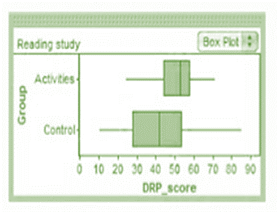
Concept explainers
(a)
To Write: a few lines comparing, on the basis of graph and numerical summaries, the DRP scores for the two groups.
(a)
Explanation of Solution
Given:


The Activity Centre seems to be greater than the control Centre, so there is a higher mean for activities and the boxplot is more correct. The spread appears to be more than the spread for the Activities group for the Control group, since it has a higher standard deviation and the distance is greater between the boxplot whiskers. Both distributions tend to be left-skewed, since in the boxplot, the median (line in the box of the boxplot) tends to be more to the right.
(b)
To Explain: the finding that an improvement in the mean DRP score was prompted by new reading practises.
(b)
Answer to Problem 51E
Yes
Explanation of Solution
Given:
Formula used:
Calculation:
The test statistic:
Degrees of freedom:
The P-value is
Enough evidence exists to support the statement that the mean DRP score for the children who took the reading activities is significantly greater.
(c)
To Explain: that it can be inferred that the latest reading practises have contributed to an improvement in the average DRP score, yes or no.
(c)
Answer to Problem 51E
Yes
Explanation of Solution
Yes, since the data was obtained by using a randomised trial and a randomised trial can show causation.
(d)
To construct: and interpret the difference in mean DRP scores for a 95 percent confidence interval and clarify that this interval presents more details than part (b) of the significance test.
(d)
Answer to Problem 51E
(0.9688, 18.9402)
Explanation of Solution
Given:
Formula used:
For the confidence interval
Calculation:
Degrees of freedom is
Finding the
The confidence interval for
There are 95% sufficient confidence that the mean difference is between 0.9688 and 18.9402.
Chapter 10 Solutions
The Practice of Statistics for AP - 4th Edition
Additional Math Textbook Solutions
Essentials of Statistics (6th Edition)
Introductory Statistics
Statistics: The Art and Science of Learning from Data (4th Edition)
Introductory Statistics (2nd Edition)
Elementary Statistics
 MATLAB: An Introduction with ApplicationsStatisticsISBN:9781119256830Author:Amos GilatPublisher:John Wiley & Sons Inc
MATLAB: An Introduction with ApplicationsStatisticsISBN:9781119256830Author:Amos GilatPublisher:John Wiley & Sons Inc Probability and Statistics for Engineering and th...StatisticsISBN:9781305251809Author:Jay L. DevorePublisher:Cengage Learning
Probability and Statistics for Engineering and th...StatisticsISBN:9781305251809Author:Jay L. DevorePublisher:Cengage Learning Statistics for The Behavioral Sciences (MindTap C...StatisticsISBN:9781305504912Author:Frederick J Gravetter, Larry B. WallnauPublisher:Cengage Learning
Statistics for The Behavioral Sciences (MindTap C...StatisticsISBN:9781305504912Author:Frederick J Gravetter, Larry B. WallnauPublisher:Cengage Learning Elementary Statistics: Picturing the World (7th E...StatisticsISBN:9780134683416Author:Ron Larson, Betsy FarberPublisher:PEARSON
Elementary Statistics: Picturing the World (7th E...StatisticsISBN:9780134683416Author:Ron Larson, Betsy FarberPublisher:PEARSON The Basic Practice of StatisticsStatisticsISBN:9781319042578Author:David S. Moore, William I. Notz, Michael A. FlignerPublisher:W. H. Freeman
The Basic Practice of StatisticsStatisticsISBN:9781319042578Author:David S. Moore, William I. Notz, Michael A. FlignerPublisher:W. H. Freeman Introduction to the Practice of StatisticsStatisticsISBN:9781319013387Author:David S. Moore, George P. McCabe, Bruce A. CraigPublisher:W. H. Freeman
Introduction to the Practice of StatisticsStatisticsISBN:9781319013387Author:David S. Moore, George P. McCabe, Bruce A. CraigPublisher:W. H. Freeman





